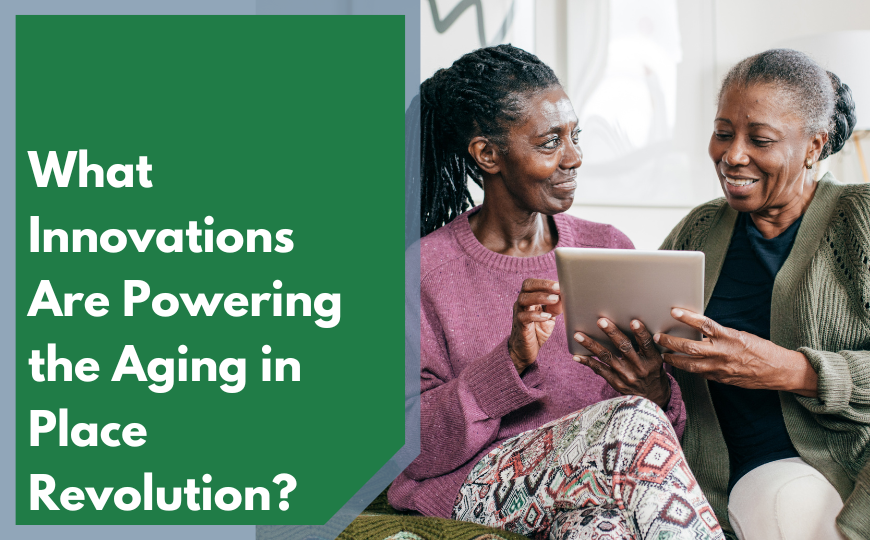Aging in place is no longer a niche trend. It’s a full-blown shift in how Americans view aging, retirement, and long-term care. Today, nearly 1 in 6 Americans is over 65. By 2030, that number is expected to rise to 1 in 5. As insight polls consistently show, the overwhelming majority of senior citizens want to stay in their homes for as long as possible.
This preference toward aging in place has been reshaping industries across the board, from healthcare to home design to technology. At the center of it all are innovations designed to support independence, safety, and dignity in aging.
For business leaders of the senior-serving industry, understanding the technology and consumer expectations driving this change will help you make the necessary decisions to better support your customers and increase sales. In this article, let’s take a closer look at the key innovations fueling the aging in place movement. Our goal is to help your company position itself competitively in this fast-growing space.
Smart Home Technology: Independence by Design
Smart home technology has gone beyond convenience to focus on enabling homeowners with independence as long as possible. Today’s aging-in-place market is flooded with user-friendly devices designed specifically for seniors and their caregivers.
Fall detection systems, for example, use motion sensors or wearable tech to automatically alert loved ones or emergency services about a potential problem. This single innovation can mean the world of difference for an older adult—hours on the floor or immediate help.
Voice-activated assistants are another essential tool. Devices like Alexa or Google Assistant let users control lights, thermostats, and even door locks with simple voice commands. For seniors with mobility limitations or vision impairment, that level of control can restore autonomy and also reduce caregiver stress.
What’s important here is integration. When these technologies are thoughtfully combined—say, motion-triggered lighting paired with voice-activated reminders—they support daily routines in ways that feel natural and seamless, not technical.
Health Monitoring: Extending Care Beyond the Clinic
Another area of rapid innovation is remote health monitoring. Wearable devices are now widely used to track heart rate, sleep, activity, and more. The biggest shift in this area, however, is with connected monitoring platforms. These tools allow physicians and caregivers to track vital signs in real time without the need for frequent in-office visits.
For seniors managing chronic conditions like diabetes or heart disease, this can be transformative—they receive timely care, providers get better data, and families gain peace of mind. This kind of tech is especially helpful for underserved or rural areas where healthcare access may be limited and the thought of planning an in-office visit is inconvenient. It’s also giving rise to hybrid care models that blend in-person and virtual support—something the post-pandemic healthcare landscape is increasingly embracing.
Home Modifications: Safety Starts with the Space Itself
Not all innovation is digital. Some of the most meaningful changes are happening in the physical home environment. Aging in place design focuses on minimizing risk and maximizing comfort, including everything from no-threshold showers and widened doorways to grab bars, non-slip flooring, and stairlifts.
The biggest change in this space is the way these solutions are designed and delivered. The best innovations don’t simply serve a functional purpose but also blend seamlessly with modern home aesthetics. Think adjustable kitchen counters that look high-end or safety rails that double as stylish towel bars.
For businesses in construction, design, or home improvement, this represents a significant opportunity. As demand rises for these aging-friendly features, so will the value of companies that can install, maintain, and consult on them.
Marketing Opportunities: Meet the Moment with the Right Message
Innovation without visibility falls flat. If you’re bringing aging in place solutions to market, how you position them matters as much as how well they work. Consider these two strategies to help bridge the gap between product innovation and customer adoption:
1. Use Digital Content to Show, Not Just Tell
Today’s buyers—including adult children, caregivers, and seniors themselves—are doing their research online. They want to understand what your product does, why it matters, and how it fits into their life or care plan.
This is where high-quality, educational digital content becomes essential.
- Create demo videos that walk through product usage in a relatable, real-life setting.
- Develop blogs that answer practical questions like “Is a stair lift right for my parents?” and “What are the best smart devices for seniors with limited mobility?”
- Share testimonials from users or caregivers who’ve seen real results.
The goal? Build trust, demonstrate value, and position your brand as an authority—not just any old vendor.
2. Partner with Healthcare Providers for Maximum Reach
Your next best marketing channel might not be a platform—it could be a person. Healthcare providers, physical therapists, and home care agencies are uniquely positioned to recommend aging in place tools to the people who need them most.
If you haven’t already, start building referral partnerships with senior care professionals. Equip them with co-branded materials, educational guides, or even product demos they can share with their patients.
Better yet, co-host events or webinars focused on home safety or health management for aging adults. These not only boost your brand’s credibility but also generate high-quality leads through trusted networks.
Case Study: Smart Tech Meets Smart Distribution
Let’s imagine a scenario with a company that’s doing it right: a tech startup that created a line of voice-activated, senior-focused smart home devices.
Instead of going straight to market, the company partnered with a national healthcare provider to distribute the devices to eligible patients through their care plans. Together, they hosted in-person demo days, built out a digital content library, and developed an onboarding process that helped both seniors and caregivers learn how to use the new technology.
The result? A sharp uptick in adoption, a consistent reduction in caregiver stress, and a steady increase in brand awareness. By blending innovation with intentional distribution, this startup didn’t just launch a product—they offered a real, practical solution that got results.
The Bottom Line: Lead Where Others Follow
Aging in place is here to stay, and the innovations supporting it are only getting better. Whether your company offers products, services, or technology in this space, now is the time to align your strategy with the real needs of aging adults and their families.
The opportunity is bigger than revenue—it’s relevance. Companies that take this market seriously and invest in both empathy and execution will emerge as leaders in one of the most critical and compassionate industries of our time.
If your business is innovating in the aging space or considering how to enter it now is the time to act. Follow us for more insight with our monthly newsletters or reach out directly if you’d like to discuss how we can help you grow your impact in this rapidly evolving market. We’re here to support you as you shape the future of aging with purpose!



